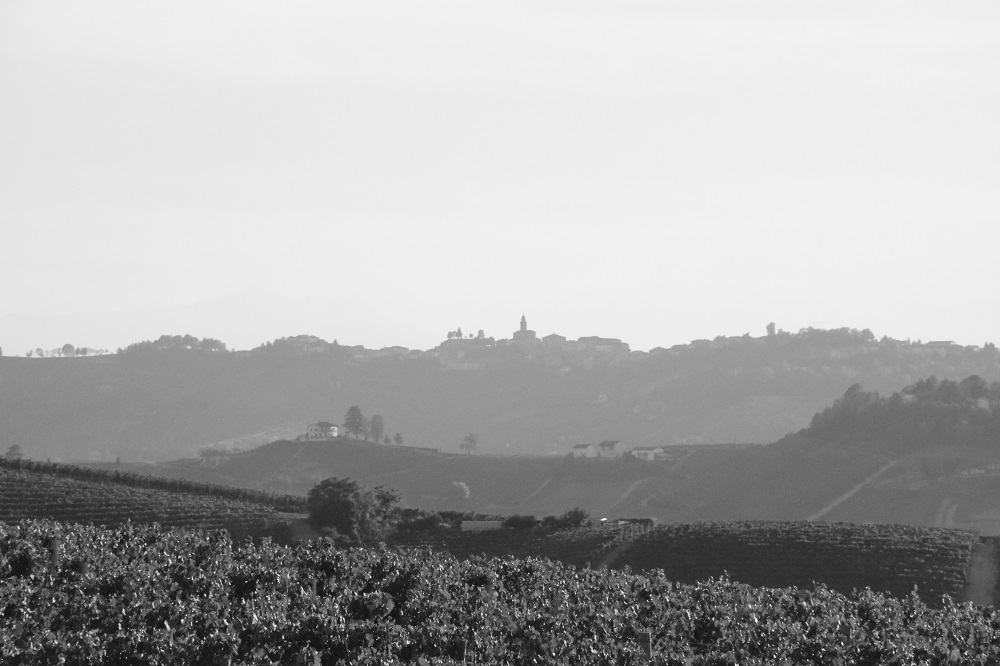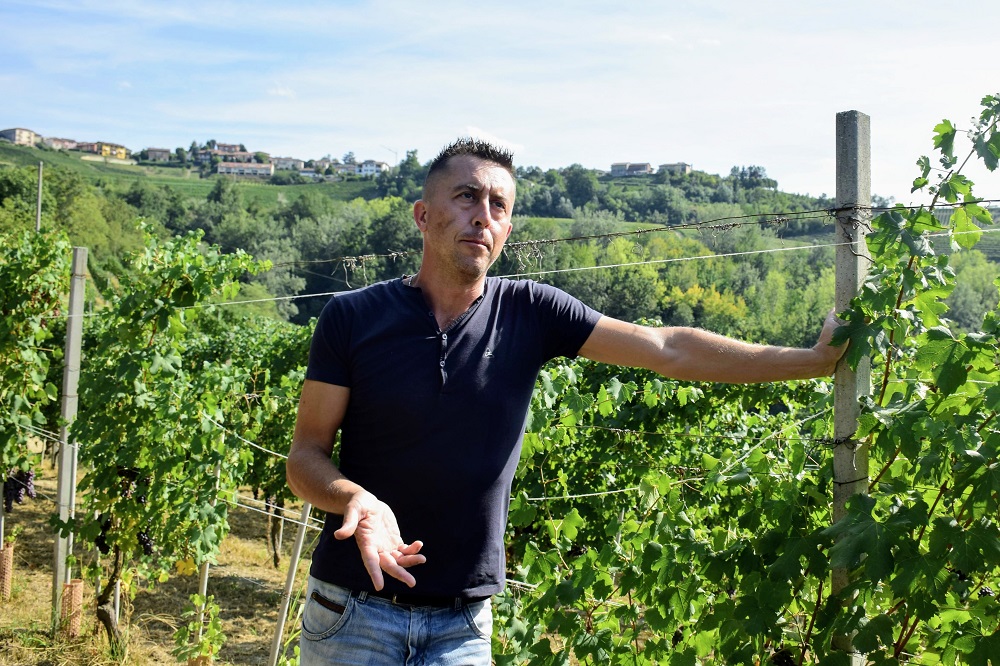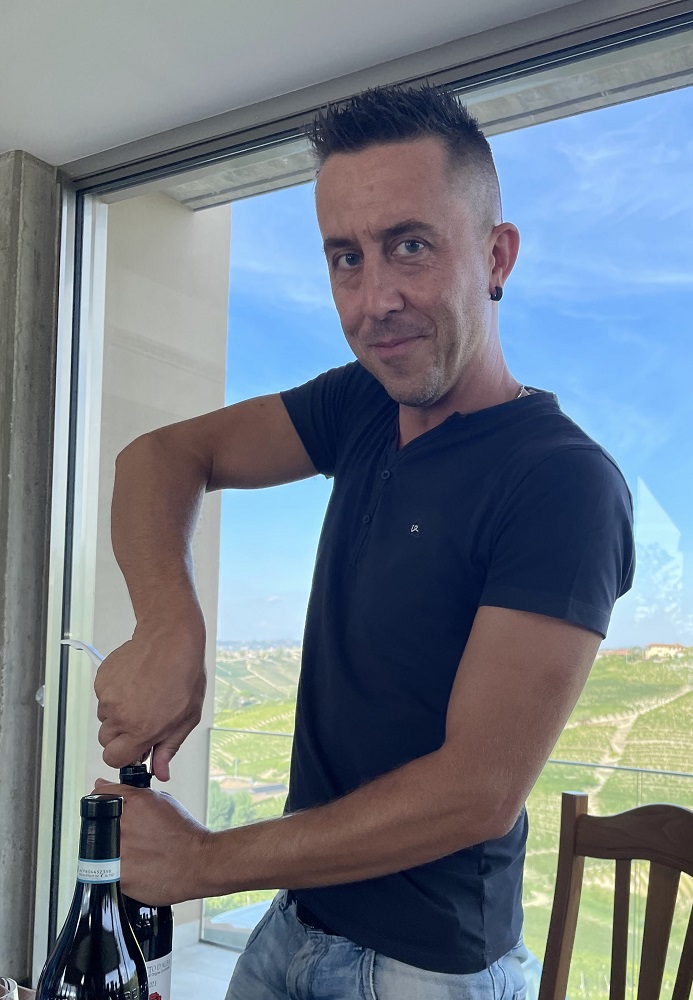Azienda Agricola Nada Giuseppe, Barbaresco

| Country & Region | Italy, Piemonte |
| Appellation(s) | Barbaresco |
| Producer | Nella, Barbara, Enrico and Fabio Nada |
| Founded | 1900 |
| Website | nadagiuseppe.it/?lang=en |
Enrico Nada is a rising young star making a range of impressive wines and a downright stunning Barbaresco from a steep, perfectly exposed Cru called Casot near Treiso.
–Michael Franz, winereviewonline.com, June 2013
On March 27, 1900, a forefather of Giuseppe Nada sealed a deal on a vineyard, orchard, and a small house on a steep hillside in the commune of Treiso. The vineyard was in the cru of Casot, and that forefather bought the parcel from a fellow by the name of Gaja. Here’s the lower half of Casot; the upper half is even steeper.

In 1964 Giuseppe’s father, Antonio, made the risky decision to begin to estate bottle a part of his production, requiring him to invest in a small winery (he put it in the basement of that house on the Casot hillside). It was a prescient move: in 1966 the DOC of Barbaresco, named after one of the three villages in the appellation, became established.
In 1968 Antonio moved to the other side of the ridge, but closer to the top so he had a better view. Probably more importantly, the location made it much easier to receive grapes from the Casot parcel as well as his Marcarini parcel on the other side of the hill. He built a new basement winery and put his house on top. Subsequently, his son Giuseppe and wife Nella raised a family there and over the years carefully enlarged the vineyards and production. Below is a view of Trieso and its church from the house.

At midpoint, Marcarini stands at 325 meters; Casot at 315 (low by Treiso’s standards), and the two occupy flanking positions on the same ridge coming down off the spine of Treiso. The Nada holdings in the two constitute six hectares (almost 15 acres), and for a long time this was the sum total of the wines owned by this industrious family. In 2022, Giuseppe’s son Enrico increased the vineyard size by a half hectare that he purchased, a virgin parcel in the Alta Langa DOCG.

Enrico “officially” became cellar master in 2008 upon graduating from enology school. He quickly eliminated SO2 additions during fermentation, maceration and malolactic, and reduced the additions used during aging. He moved to employing only one minimal filtration at bottling for the reds. He embarked on what to some eyes seemed a Quixotic quest and planted Riesling–which turned out to be an astonishing success–while convincing his father to go organic in the vines. (His father worked the vines until the pandemic, and then passed away in 2023, shortly after Enrico’s nephew Fabio began working in the vines and cellar.) The red parcels received certification in 2017; the white parcels were certified in 2018 and 2019. All parcels, of course, continue to be hand-harvested, and all the red wines continue to be fermented spontaneously (Enrico uses a selected organic yeast for the white wines).
In 2022 Enrico became president of the Cuneo chapter of the Coldiretti agricultural syndicate, which coordinates between farmers and governments on all levels for just about everything produced agriculturally in Italy. It’s a five-year post. As if that didn’t make him busy enough (he also has two young daughters), he couldn’t pass up the opportunity to buy the half hectare parcel in the Alta Langa in 2022. It’s an extremely steep parcel with a 25-30% grade, just cleared, in the middle of a forest. There is only one other parcel nearby, some thirty yards away, newly planted and of roughly the same size, owned by Gaja. Immediately on the other side of the ridge from these two parcels is the ambitious new winery Gaja completed just before the pandemic to make wines from this appellation. Despite its name (high language, referring to the language of these hills), the Alta Langa isn’t based on altitude but rather on its location outside of the Barbaresco appellation and on its dedication to sparkling wine. Regardless, Enrico’s parcel is about elevation; it’s why he bought it. The church in Treiso sits at 410 meters, considerably higher than Barbaresco’s church, let alone Neive’s. Enrico’s new parcel reaches nearly 680 meters. Plus, it’s east-facing and surrounded by cooling forests. Here, once the ground is replenished by grasses and legumes that have been seeded, Chardonnay and Pinot Noir will be planted for sparkling wine, along with Riesling. The success of Enrico’s Riesling in the Marcarini vineyard has made him a convert.
The three towns comprising the Barbaresco DOCG are Treiso, Neive, and Barbaresco (there’s also the hamlet of San Rocco Seno d’Elvio, which anchors the commune of Alba’s small sector in the southwest of the appellation). They form a triangle: Barbaresco in the west, Neive in the east, and Treiso—the smallest in acreage and highest in elevation—in the south. Innately, Barbaresco and Treiso lean toward elegance while Neive can pack more power and structure, but the differences can be readily rendered mute by the hand of man. It is worth noting, however, that if it snows, it snows first in Treiso, and Treiso’s altitudes give it the widest diurnal swings. Treiso has around 1,000 inhabitants, including three wine producing families with the name Nada. They are producers known as Ada Nada, Fiorenzo Nada, and of course Giuseppe Nada.

Down in the river valley is the small, ancient city of Alba, effectively separating Barbaresco from Barolo, Piedmont’s two great regions for Nebbiolo. They sit about ten miles apart, but much more than distance separates them.
To begin, Barolo had a head start over Barbaresco by several generations. Its reputation was built in the 19th century by selling slightly sweet Nebbiolo wine to the French court of Savoy in Turin. Toward the end of that century, the farmers in Barbaresco petitioned to have their region’s crop included into the production of Barolo, but were denied. In 1894, an enologist from Barbaresco got nine families to form a cooperative, and Barbaresco, the wine, got its first real push. The cooperative closed in the 1920s under restrictive economic rules issued by the Fascists and only re-opened, thanks to the village priest, in 1958 under the name of Produttori Del Barbaresco.
In acreage, the DOCG of Barbaresco is just over a third of the size of Barolo at roughly 1,200 acres versus Barolo’s 3,000. It has three communes to Barolo’s eleven. It is ever so slightly warmer during a normal growing season, and its grapes typically ripen a bit earlier than in Barolo. The soils are similar and similarly quite diverse, but, generally, Barbaresco, being closer to the Tanaro River, has more alluvial soils with more sand whereas Barolo has a bit more limestone and clay (these are generalities; specific sites can quickly counter them). When it comes to wine, alluvial soils translate into elegance and perfume; clay translates into structure and power, hence Barbaresco’s reputation as the Queen and Barolo’s as the King—in her you find Nebbiolo’s rose petals, in him you find its tar. Lastly, legally, Barbaresco must be aged for a minimum of two years, with at least nine months of that in wood; Barolo must be aged for three years, with at least two of them in wood (for both wines, the remainder of time can be spent in vat or bottle). Note that the rule mandating length of time in wood for Barbaresco changed in 2010–it used to mandate 12 months in wood–and what Enrico Nada does is age his Barbaresco in various sizes of barrels for two years before bottling, and puts the wine on the market shortly thereafter.

The Wines
| Wine | Blend | Description |
|---|---|---|
| Metodo Classico NV | Nebbiolo | A Méthode Champenoise wine made from Nebbiolo grown in Marcarini and blended with around 3% Riesling. There's no mention of the varietals on the label because this isn't permitted. The wine is a single-vintage wine, and the lot number on the front label indicates which vintage (for example, Lot 129/18 means the wine was put into bottle for its secondary fermentation the 129th day of 2018, hence vintage 2017). There are several disgorgements, the first happening after 42 months of aging. Dosage is zero. Tech sheet here. |
| Langhe Rosato | Nebbiolo | From both Barbaresco and DOC Nebbiolo parcels, coming from what amounts to a cluster thinning done 2 to 3 weeks in advance of the red wine harvest. This preserves aromatics, acidity, and restraint in alcohol levels for the rosé while concentrating remaining clusters for the red wines. Made in tank and bottled after 3 to 4 months on its fine lees. 200 cases annually. |
| Langhe Riesling "Tecum" | Riesling | From vines on top of the Marcarini hillside. Usually, experimental grapes like this are planted at the bottom of the hillsides where it's known that the favored son Nebbiolo grows too vigorously in the rich soil but where, of course, cooling breezes and diurnal swings are at a minimum. At the moment, this comes from two parcels in the Marcarini vineyard (in 2027 or so Enrico's Riesling from the new Alta Lange parcel will be in production). The original parcel consists of the first two rows at the top of the long hill, sheltered from the afternoon sun by the winery. The second parcel is just a bit further downslope, and this northeast-facing hillside makes for excellent acid retention in the grapes. The wine rests on its fine lees for about six months and then is matured in bottle for three years before being released. Current production is around 150 cases. Stylistically, it's closer to dry Alsatian Riesling than it is to German Riesling. Enrico's sister Barbara was a classics major, and Tecum is Latin for with you. Tech sheet here. |
| Armonia Langhe Bianco DOC: | Essentially half Arneis and half Sauvignon Blanc | A Piedmontese white with terrific aromatics and a textured body, the latter coming from low yields and a very low addition of SO2 rather than any oak aging (it's raised in steel) or battonage. This wine is bottled early and does not undergo malolactic fermentation. Production is around 800 cases annually. Armonia means harmony, in this case between the different varieties, their strengths, acidities, and perfumes. Tech sheet here. |
| Dolcetto d’Alba | Dolcetto | This is a quintessentially fresh Dolcetto that looks toward fruit and deliciousness over alcohol and power. These grapes come from a parcel of just over two acres in the hills of Diano d'Alba, effectively between the Barbaresco and Barolo appellations. The vines were planted in the 1980s and Enrico follows the vineyard operation throughout the season and then buys the grapes. He only bottles around 300 cases yearly and sells the rest of the wine off in bulk. Tech sheet here. |
| Barbera d’Alba Superiore | Barbera | Superiore designation is reserved for Barbera that is aged a minimum of 4 months in barrel. Nada ages its Barbera for one year in a mix of new and older 500L tonneaux. This all comes from Marcarini, a northeast-facing site that gives red fruit and elegance to Barbera’s meat and blood. ~300 cases annually. Tech sheet here. |
| Langhe Nebbiolo | Nebbiolo | Primarily from Marcarini, from parcels designated for this bottling, or from young vines, or declassified Barbaresco (sometimes a combination of all 3!). Those parcels designated for this cuvée are usually picked a few days earlier than those parcels designated for Barbaresco, and macerations generally last no more than three weeks. Élevage lasts from 8 to 12 months and, like the Barbera, the aging takes place in tonneaux and botticelle (that is, 500 and 1,000-liter barrels), but for the Langhe Nebbiolo none of the wood is new. Around 700 cases annually. Tech sheet here. |
| Barbaresco | Nebbiolo | Starting in 2019, Enrico introduced this wine, a small production intended for those who want a wine with the structure of the Nada crus but with the approachability of the Nada Langhe Nebbiolo. That is, a wine in between the two styles. The grapes for this wine are purchased from a family relative in the commune of Neive who farms sustainably and isn't certified organic. Fermentation takes place spontaneously in Enrico's cellar and the length of maceration is closer to the Langhe Nebbiolo--3-4 weeks--while élevage lasts for one year in large, neutral foudres. Production averages 250 cases. |
| Barbaresco Casot | Nebbiolo | Pronounced ca-zot with a hard t, like hot. Nada has 8.6 acres here, 90% of which is Nebbiolo planted in 1960. Exposure is to the southwest, making it a warmer site than Marcarini. For Barbarescos coming from Casot and Marcarini, macerations go for at least six weeks, and often eight. For its first year, the wine is aged in a combination of 500L tonnaux and 1,000L botticelli oak barrels, always used, then it's racked into 3-4,000L Slavonian and French casks for another year. Bottled without fining and with only a very light filtration. As many as 1,000 cases can be made in a productive year. Tech sheet here. |
| Barbaresco Marcarini | Nebbiolo | The Marcarini parcel belonging to the Nada family has 5 acres of vines, 1.5 of which is Nebbiolo planted in the late 1970s. Marcarini faces east with a slight tilt to the north, so, technically east-northeast, and catches the cooler morning sun while Casot, on the other side of the steep ridge, gets the warmer afternoon sun. This wine is made and raised essentially the same as the Casot Barbaresco. Tech sheet here. |
| Barbaresco Riserva Casot | Nebbiolo | A further selection of grapes in Casot, aged for four years: first two years normally in 1,000L botticelle and then another two in big Slavonian casks, followed by a minimum of six months in bottle. The year depending, anywhere from 250 to 500 cases made. |
| Barbaresco Casmar Riserva | Nebbiolo | This cuvée started with vintage 2016, a short crop, which induced Enrico to blend the best of his two crus--Casot and Marcarini--to make that year's riserva. The name is an abbreviation of the two. Total production is 3-4,000 bottles. Tech sheet here. |